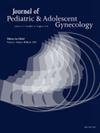11. Addressing Cervical Cancer Disparities in Adolescents with Disabilities through HPV Vaccination
IF 1.8
4区 医学
Q3 OBSTETRICS & GYNECOLOGY
引用次数: 0
Abstract
Background
Adolescents with disabilities (AWD) are often viewed as nonsexual, posing challenges in receiving sexual healthcare. Yet, patients with disabilities have higher rates of sexual abuse and unprotected sex and lower rates of cervical cancer screening. It is critical that AWD receive the HPV vaccination due to their risk of HPV exposure and lower likelihood of receiving routine cervical cancer screening. This study aims to assess if there is a discrepancy in HPV vaccination between AWD and their non-disabled peers.
Methods
A retrospective cohort study was conducted of adolescent females ages 16-21 years attending any visit in an academic health system from July 2021 - September 2024. Data collected included demographics, disability status, and receiving at least one dose of the HPV vaccine. Disability status was defined by the Children with Disabilities Algorithm (Agency for Healthcare Research and Quality), which uses ICD-9 codes to classify physical, sensory, developmental/behavioral, psychological, and intellectual disabilities. The primary outcome was differences in HPV vaccination between adolescents with specific disabilities, any disability, and non-disabled peers. Analysis included Chi-square tests and logistic regression. This study was exempt by IRB.
Results
Of 7,801 total adolescents, 1,132 (14.5%) were identified as having any disability, 5,785 (74.2%) of all patients received at least one dose of the HPV vaccine, and 870 (76.9%) patients with disabilities received at least one dose. Any disability was associated with higher HPV vaccination rate (p=0.025). Psychological and sensory disabilities were significantly associated with higher HPV vaccination rates (p=0.011; p=0.039), whereas intellectual disability was nearly significantly associated with lower HPV vaccination rates (p=0.07). Physical and developmental disabilities were not associated with HPV vaccination. Compared to white race, non-Black racial minorities had a significantly higher HPV vaccination rate (p=0.031). There was no significant difference between HPV vaccination among disabilities according to race. Older age was significantly associated with HPV vaccination (p=0.006). See Table 1.
Conclusions
Adolescents with psychological and sensory disabilities had higher HPV vaccination rates, suggesting lower cervical cancer risk. However, adolescents with intellectual disabilities may experience lower rates, exposing a potential disparity in cervical cancer risk. Providing patients and parents with education on HPV exposure and cancer risk tailored to the adolescent's disability may decrease barriers to HPV vaccination.
11. 通过HPV疫苗接种解决残疾青少年宫颈癌的差异
背景残疾青少年(AWD)通常被认为是无性的,在接受性保健方面提出了挑战。然而,残疾患者遭受性虐待和无保护的性行为的比例较高,接受子宫颈癌筛查的比例较低。由于AWD的HPV暴露风险和接受常规宫颈癌筛查的可能性较低,因此接受HPV疫苗接种至关重要。本研究旨在评估AWD和非残疾同龄人之间是否存在HPV疫苗接种差异。方法对2021年7月至2024年9月在某学术卫生系统就诊的16-21岁青春期女性进行回顾性队列研究。收集的数据包括人口统计、残疾状况和接受至少一剂HPV疫苗。残疾状态由残疾儿童算法(医疗保健研究和质量机构)定义,该算法使用ICD-9代码对身体、感官、发育/行为、心理和智力残疾进行分类。主要结果是有特殊残疾、任何残疾和非残疾青少年之间HPV疫苗接种的差异。分析包括卡方检验和逻辑回归。本研究获IRB豁免。结果在总共7801名青少年中,1132名(14.5%)被确定为有任何残疾,5785名(74.2%)患者至少接种了一剂HPV疫苗,870名(76.9%)残疾患者至少接种了一剂HPV疫苗。任何残疾与较高的HPV疫苗接种率相关(p=0.025)。心理和感觉障碍与较高的HPV疫苗接种率显著相关(p=0.011;p=0.039),而智力残疾与HPV疫苗接种率较低几乎显著相关(p=0.07)。身体和发育障碍与HPV疫苗接种无关。非黑人少数民族的HPV疫苗接种率明显高于白人(p=0.031)。在不同种族的残疾人中,HPV疫苗接种没有显著差异。年龄较大与HPV疫苗接种显著相关(p=0.006)。见表1。结论有心理和感觉障碍的青少年HPV疫苗接种率较高,提示宫颈癌风险较低。然而,有智力障碍的青少年发病率可能较低,暴露出宫颈癌风险的潜在差异。为患者和家长提供针对青少年残疾的HPV暴露和癌症风险的教育,可能会减少HPV疫苗接种的障碍。
本文章由计算机程序翻译,如有差异,请以英文原文为准。
求助全文
约1分钟内获得全文
求助全文
来源期刊
CiteScore
3.90
自引率
11.10%
发文量
251
审稿时长
57 days
期刊介绍:
Journal of Pediatric and Adolescent Gynecology includes all aspects of clinical and basic science research in pediatric and adolescent gynecology. The Journal draws on expertise from a variety of disciplines including pediatrics, obstetrics and gynecology, reproduction and gynecology, reproductive and pediatric endocrinology, genetics, and molecular biology.
The Journal of Pediatric and Adolescent Gynecology features original studies, review articles, book and literature reviews, letters to the editor, and communications in brief. It is an essential resource for the libraries of OB/GYN specialists, as well as pediatricians and primary care physicians.

 求助内容:
求助内容: 应助结果提醒方式:
应助结果提醒方式:


